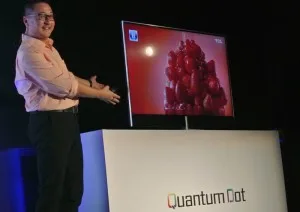HiSense Switches to QD Vision
 Hisense has been using the QDEF for its ULED TVs, but will now transition to QD Vision’s linear optical element for of its sets. Changhong is using QDEF, and Samsung will use the film approach when it begins manufacturing this year. LG is also using the film approach.
Hisense has been using the QDEF for its ULED TVs, but will now transition to QD Vision’s linear optical element for of its sets. Changhong is using QDEF, and Samsung will use the film approach when it begins manufacturing this year. LG is also using the film approach.
Harlove said that QDEF sets are now achieving 90% of REC.2020. Nanosys worked with Dolby and the chip vendor, and customized the dots to do this. With a better blue filter, the company could do 97%, which has been shown in a demonstration unit.
Some vendors have spoken of “QD on chip” – putting the quantum dots directly on the LED chip – as being the ideal solution. Hartlove thinks there is a lot of work that needs to be done before this can be achieved. For Hartlove, the ultimate solution is the emissive quantum-dot display, in which the QDs are energized by an electric field instead of optically. He feels this is more interesting than QD on chip. The emissive QD display is sometimes called “QLED,” a name that has been copyrighted by QD Vision.
Whatever Nanosys winds up calling it, that is where Nanosys’s roadmap will head eventually. In the nearer term, Nanosys is aiming to make QD-enhanced systems cost-neutral.

